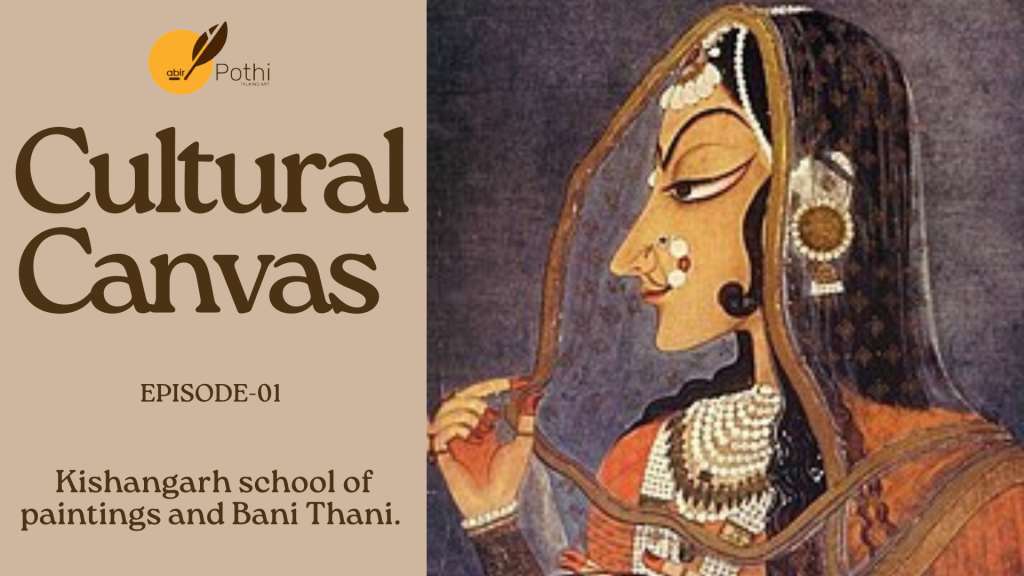Introduction
The vibrant history of Indian art is often punctuated by the emergence of distinct regional schools that not only reflect the cultural ethos of their times but also stand as enduring legacies of aesthetic brilliance. One such remarkable tradition is the Keeshangarh School of Painting, rooted in the state of Keeshangarh, founded in 1609 by Keeshan Singh, a scion of the royal family of Jodhpur. This school, which blossomed under royal patronage, particularly during the reigns of Maan Singh and Raj Singh, is celebrated for its distinctive style and its profound depiction of the divine love of Radha and Krishna.
The Origins and Evolution of the Keeshangarh School
The Keeshangarh School began to take shape under the patronage of Maan Singh (1658–1706). By this time, artists in the regional court had started developing a unique visual language that would later characterize the school’s style. Maan Singh’s reign set the foundation for a flourishing artistic tradition that saw its zenith during the early eighteenth century, under the rule of Raj Singh (1706–1748). During this period, the Keeshangarh style became distinguished by its elongation of the human form, lavish use of green, and a penchant for depicting panoramic landscapes. These elements combined to create a visual experience that was both ornate and serene.
Raj Singh’s initiation into the Pushtimargiya cult of Vallabha-charya marked a pivotal moment in the thematic direction of the Keeshangarh School. With a newfound devotion to Krishna Lila (the divine play of Krishna), the art of the region began to reflect this spiritual focus. The depiction of Krishna and Radha in courtly settings, surrounded by expansive and detailed landscapes, became a favored subject in the royal court’s artistic repertoire. This period saw the integration of spiritual themes with the aesthetic sensibilities of the time, leading to a rich body of work that was both devotional and visually captivating.
Sawant Singh and Nihal Chand: The Golden Era
The golden era of the Keeshangarh School is inextricably linked with the reign of Maharaj Sawant Singh, the eldest son of Raj Singh, and his celebrated court artist, Nihal Chand. Sawant Singh, who ruled between 1735 and 1757, was not only a patron of the arts but also a poet who composed under the pen name Nagari Das. His devotional poetry, which centered on the divine love of Radha and Krishna, provided the thematic foundation for Nihal Chand’s masterpieces.
One of the most iconic figures associated with this era is Bani Thani, a young singer in Sawant Singh’s court who captivated the king with her beauty, grace, and talent. Bani Thani, an attendant of Raj Singh’s wife, became the muse for Sawant Singh’s poetic compositions. Her relationship with the king and her depiction in art have since become legendary. In Sawant Singh’s poem, Bihari Jas Chandrika, Bani Thani is immortalized as the embodiment of Radha, and it was Nihal Chand who translated this poetic vision into the visual realm.
Nihal Chand’s portrayal of Bani Thani as Radha is a masterpiece that has come to symbolize the Keeshangarh School’s style. The exaggerated facial features—deeply curved eyes, an exaggerated arch of the eyebrows, a pointed nose, thin lips, and a pronounced chin—became the hallmarks of this school. This distinct physiognomy is believed to have been inspired by Bani Thani’s own sharp and attractive features, which Nihal Chand idealized in his paintings. The figures of Sawant Singh and Bani Thani, often represented as Krishna and Radha, are depicted against brilliantly colored, panoramic landscapes that reflect the school’s emphasis on both detail and grandeur.
The Legacy of the Keeshangarh School
The legacy of the Keeshangarh School of Painting endures to this day, with its themes and styles continuing to inspire artists. The depiction of Bani Thani as Radha has transcended its historical context to become a cultural icon, representing the timeless beauty and elegance of Indian art. The Keeshangarh School’s fusion of devotional themes with an unparalleled aesthetic sensibility has ensured its place in the annals of Indian art history.
As we reflect on this rich tradition, it becomes clear that the Keeshangarh School is not merely a historical footnote but a vibrant chapter in the story of Indian art. It is a testament to the enduring power of art to capture and elevate the spirit, merging the earthly with the divine in a way that continues to resonate with audiences across time.
In conclusion, the Keeshangarh School of Painting, with its unique style and thematic focus, remains a symbol of the artistic and cultural richness of India. The legacy of artists like Nihal Chand and patrons like Sawant Singh ensures that the beauty of this tradition will continue to inspire and captivate for generations to come.





